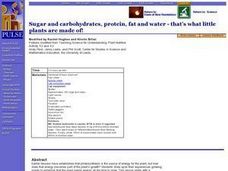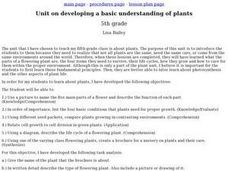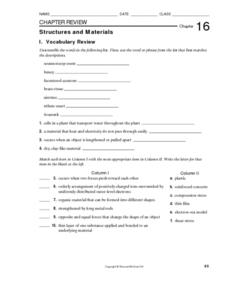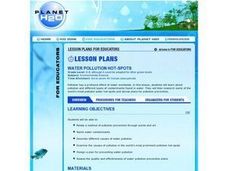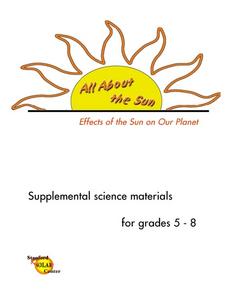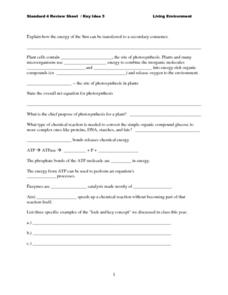Curated OER
Dietary Fiber
Students examine the different types of fiber and their benefits. For this investigative lesson students find good sources of fiber in different foods.
National Institute of Open Schooling
Radioactive Pollution
Radioactive pollutants can enter the body through ingestion, inhalation, absorption, or injection. The last lesson in a series of 36 introduces pupils to radioactive pollution. They study its sources, both natural and man-made, its...
Curated OER
Cellular Cellebrities
Sixth graders, in groups, learn the morphology and function of organelles within plant and animal cells.
Curated OER
Sugar and carbohydrates, protein, fat and water - that's what little plants are made of!
Students identify photosynthesis as the mechanism by which plants convert sunlight energy into a usable energy source for plant processes. They identify photosynthesis as the mechanism by which plants create a molecule that can be used...
Curated OER
Ferns and Gymnosperms
In this plant worksheet, students review the different characteristics of ferns and gymnosperms. This worksheet has 12 fill in the blank questions.
Curated OER
Eukaryotes vs. Prokaryotes
Seven simple slides list characteristics of eukaryotic and prokaryotic cells. After viewing this presentation, future biologists will be also able to name the unique characteristics of plant, animal, and fungal cells. Ideally, you would...
Curated OER
Different Types of Orange Juice Contain the Same Amounts of Vitamin C?
High schoolers measure and compare the amount of vitamin C in orange juice samples. They discover the effects of different factors on the concentration of vitamin C. They participate in an experiment to test the orange juice.
Curated OER
Ferns and Gymnosperms
In this fern and gymnosperm activity, students will read about two types of vascular tissue: xylem and phloem. Then students will read about the difference between sporophytes and gametophytes. Using this information students will answer...
Curated OER
Mycorrhiza
Students examine the symbiotic relationship between fungus and plants. In this ecosystem lesson students complete several mycorrhiza experiments.
Curated OER
Unit on Developing a Basic Understanding of Plants
Fifth graders study the parts of a plant, their life cycles, and how to care for them in this unit.
Curated OER
COMPARE SOILS BY GROWING PLANTS
The student will identify the difference in the rate of plant growth in three soils that vary in organic matter.1. Obtain three to four flowerpots, different types of soil, a record chart, three to five beans for each pot, and water....
Curated OER
Seedless Plants
In this plant learning exercise, students complete 1 short answer question and 6 fill in the blank statements using a word bank about seedless plants.
Curated OER
Structures and Materials
In this materials worksheet, learners will review different types of materials and the structures that can be made using these materials. This worksheet has 7 fill in the blank, 6 matching, 1 short answer, and 6 multiple choice questions.
Curated OER
Water Pollution Hot-Spots
Students complete internet research in small groups to identify types of water pollution, spotlight water pollution hot-spots, and design a plan for water prevention.
Curated OER
Vital Vitamins
Students study vitamins and who should take them and what ones to take. In this investigative lesson students plan a healthy diet after reviewing the types of supplements.
Curated OER
Effects of the Sun on Our Planet
Students examine the effect of different types of light on the Earth. They discover the role of evaporation and the effects of the sun on the magnetosphere. They also observe different solar phenomena.
Curated OER
Flower Power
Students explore the parts of flowers and how they reproduce. They dissect flowers and observe the reproductive organs. Students observe anthers and ovaries of Tiger Lilies under a microscope. They investigate how insects and other...
Curated OER
Asexual Reproduction
In this asexual reproduction worksheet, students compare and contrast different types of asexual reproduction processes by examining prepared slides and completing 20 short answer questions, 4 drawings, and 9 fill in the blank questions.
Curated OER
Grade Three Science Practice
In this grade 3 science worksheet, 3rd graders complete a set of 25 multiple choice questions related to a variety of 3rd grade science concepts. An answer key is included.
Curated OER
Standard 4-Photosynthesis, Diseases and the Immune System
In this photosynthesis, disease and Immune System worksheet, students fill in the blanks with key terms to complete sentences about the transfer of energy from the sun to plants, enzymes as catalysts in reactions, homeostasis, the immune...
Curated OER
Chloroplasts and Mitochondria
For this biology worksheet, students read about the mechanism of photosynthesis to answer 43 short answer questions. They explain the role of chloroplasts in the process.
Curated OER
Rate of Photosynthesis
Students investigate the rate of photosynthesis using elodea leaves. In this photosynthesis lesson plan, students place elodea in a test tube filled with water. They include baking soda and place the test tube under a lamp. Students...
Community Resources for Science
A Whole New World of DNA and Proteins
Lead your young scientists into an exciting world as they participate in a role play and experiment focused on proteins and DNA. After researching the Central Dogma of Biology, individuals or groups participate in a classroom...
Curated OER
Organic and Inorganic Waste
Students conduct a scientific investigation about organic or inorganic waste. In this organic or inorganic waste lesson, students create a compost heap to determine the difference between inorganic and organic waste. Students...



